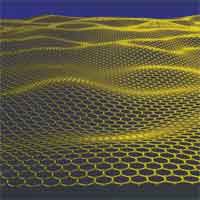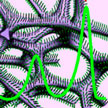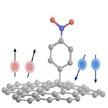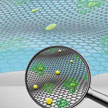Showing Spotlights 241 - 248 of 334 in category All (newest first):
 Researchers report the fabrication of flexible, durable, and self-assembled graphene textile electrodes for supercapacitors using a novel wet-spinning approach of ultra large graphene oxide liquid crystals followed by heat-treatment to obtain graphene fibers. The key to producing such fibers and yarns is to preserve the large sheet size even after the reduction of GO while simultaneously maintaining a high interlayer spacing in between graphene sheets. These graphene yarns could lead the way to the realization of powerful next-generation multifunctional renewable wearable energy storage systems.
Researchers report the fabrication of flexible, durable, and self-assembled graphene textile electrodes for supercapacitors using a novel wet-spinning approach of ultra large graphene oxide liquid crystals followed by heat-treatment to obtain graphene fibers. The key to producing such fibers and yarns is to preserve the large sheet size even after the reduction of GO while simultaneously maintaining a high interlayer spacing in between graphene sheets. These graphene yarns could lead the way to the realization of powerful next-generation multifunctional renewable wearable energy storage systems.
Mar 7th, 2014
 Graphene is undoubtedly emerging as one of the most promising nanomaterials because of its unique combination of superb properties, which opens a way for its exploitation in a wide spectrum of applications ranging from electronics to optics, sensors, and biodevices. In this Nanowerk nanotechnology primer we summarize recent finding in graphene research and show the breadth of graphene applications in such areas as energy, electronics, sensors and many others.
Graphene is undoubtedly emerging as one of the most promising nanomaterials because of its unique combination of superb properties, which opens a way for its exploitation in a wide spectrum of applications ranging from electronics to optics, sensors, and biodevices. In this Nanowerk nanotechnology primer we summarize recent finding in graphene research and show the breadth of graphene applications in such areas as energy, electronics, sensors and many others.
Jan 29th, 2014
 Recently, nanotechnology researchers have begun to work with graphene foams - three-dimensional structures of interconnected graphene sheets with extremely high conductivity. Since graphene foam possesses a high porosity of close to 100%, this offers the opportunity to use it as a scaffold for other nanomaterials to generate synergistic effects. Now, researchers have fabricated vertically aligned ZnO nanowire arrays on 3D graphene foam and used this electrode to detect uric acid in a reliable statistical level from the serum of Parkinson's disease patients.
Recently, nanotechnology researchers have begun to work with graphene foams - three-dimensional structures of interconnected graphene sheets with extremely high conductivity. Since graphene foam possesses a high porosity of close to 100%, this offers the opportunity to use it as a scaffold for other nanomaterials to generate synergistic effects. Now, researchers have fabricated vertically aligned ZnO nanowire arrays on 3D graphene foam and used this electrode to detect uric acid in a reliable statistical level from the serum of Parkinson's disease patients.
Jan 27th, 2014
 Functionalized graphene holds exceptional promise for biological and chemical sensors. In new work, researchers have shown that the distinctive 2D structure of graphene oxide, combined with its superpermeability to water molecules, leads to sensing devices with an unprecedented speed. The team reports the experimental observation of the unparalleled response speed of humidity sensors based on graphene oxide, which are - to the best of the scientists' knowledge - the fastest humidity sensors ever reported.
Functionalized graphene holds exceptional promise for biological and chemical sensors. In new work, researchers have shown that the distinctive 2D structure of graphene oxide, combined with its superpermeability to water molecules, leads to sensing devices with an unprecedented speed. The team reports the experimental observation of the unparalleled response speed of humidity sensors based on graphene oxide, which are - to the best of the scientists' knowledge - the fastest humidity sensors ever reported.
Nov 27th, 2013
 One item that so far has been missing from graphene's impressive list of physical properties is magnetism. In its pristine state, graphene exhibits no signs of the conventional magnetism usually associated with such materials as iron or nickel. So far, no reports that provide comprehensive evidence for either macro- or nanoscale magnetic phenomena for the ferromagnetism of carbon nanostructures in chemically functionalized graphene structures have appeared in the literature. Researchers have now filled this gap.
One item that so far has been missing from graphene's impressive list of physical properties is magnetism. In its pristine state, graphene exhibits no signs of the conventional magnetism usually associated with such materials as iron or nickel. So far, no reports that provide comprehensive evidence for either macro- or nanoscale magnetic phenomena for the ferromagnetism of carbon nanostructures in chemically functionalized graphene structures have appeared in the literature. Researchers have now filled this gap.
Nov 5th, 2013
 Material science is having a renewed influence on bioelectronics design beyond the incorporation of new functional nanomaterials. This newly established cooperation opens new windows for bioelectronics research, especially for fabricating flexible and smart devices. Recent advances in graphene research provide various possibilities to enhance performance characteristics and current approaches to design new bio-devices. Especially, smart and flexible bioelectronics on graphene has emerged as a new frontier in this area.
Material science is having a renewed influence on bioelectronics design beyond the incorporation of new functional nanomaterials. This newly established cooperation opens new windows for bioelectronics research, especially for fabricating flexible and smart devices. Recent advances in graphene research provide various possibilities to enhance performance characteristics and current approaches to design new bio-devices. Especially, smart and flexible bioelectronics on graphene has emerged as a new frontier in this area.
Oct 31st, 2013
 The future of your clothes will be electronic. Not only will electronic devices be embedded on textile substrates, but an electronics device or system could become the fabric itself. These electronic textiles will have the revolutionary ability to sense, compute, store, emit, and move - think biomedical monitoring functions or new man-machine interfaces, not to mention game controllers - while leveraging an existing low-cost textile manufacturing infrastructure. In new work, a group of scientists from Korea have now reported novel method for the fabrication of conductive, flexible, and durable graphene textiles wrapped with reduced graphene oxide.
The future of your clothes will be electronic. Not only will electronic devices be embedded on textile substrates, but an electronics device or system could become the fabric itself. These electronic textiles will have the revolutionary ability to sense, compute, store, emit, and move - think biomedical monitoring functions or new man-machine interfaces, not to mention game controllers - while leveraging an existing low-cost textile manufacturing infrastructure. In new work, a group of scientists from Korea have now reported novel method for the fabrication of conductive, flexible, and durable graphene textiles wrapped with reduced graphene oxide.
Oct 29th, 2013
 Technology in our lives is ever more based on miniaturized structures that deliver higher performance devices taking up a fraction of the space compared to several years ago. But seeing what is going on at these tiny length scales comparable to molecules is very hard. Normally light cannot be used since it is not focused tightly enough, limited by the optical wavelength which is much larger than the structures we want to observe. New research suggests that tightly squeezing light into small gaps in metallic nanostructures now provides a way to circumvent this problem.
Technology in our lives is ever more based on miniaturized structures that deliver higher performance devices taking up a fraction of the space compared to several years ago. But seeing what is going on at these tiny length scales comparable to molecules is very hard. Normally light cannot be used since it is not focused tightly enough, limited by the optical wavelength which is much larger than the structures we want to observe. New research suggests that tightly squeezing light into small gaps in metallic nanostructures now provides a way to circumvent this problem.
Oct 22nd, 2013
 Researchers report the fabrication of flexible, durable, and self-assembled graphene textile electrodes for supercapacitors using a novel wet-spinning approach of ultra large graphene oxide liquid crystals followed by heat-treatment to obtain graphene fibers. The key to producing such fibers and yarns is to preserve the large sheet size even after the reduction of GO while simultaneously maintaining a high interlayer spacing in between graphene sheets. These graphene yarns could lead the way to the realization of powerful next-generation multifunctional renewable wearable energy storage systems.
Researchers report the fabrication of flexible, durable, and self-assembled graphene textile electrodes for supercapacitors using a novel wet-spinning approach of ultra large graphene oxide liquid crystals followed by heat-treatment to obtain graphene fibers. The key to producing such fibers and yarns is to preserve the large sheet size even after the reduction of GO while simultaneously maintaining a high interlayer spacing in between graphene sheets. These graphene yarns could lead the way to the realization of powerful next-generation multifunctional renewable wearable energy storage systems.

 Subscribe to our Nanotechnology Spotlight feed
Subscribe to our Nanotechnology Spotlight feed





